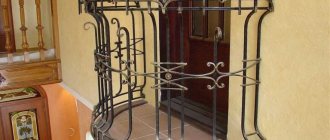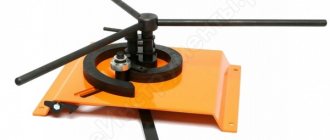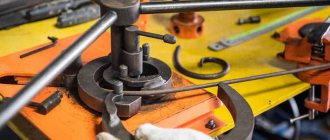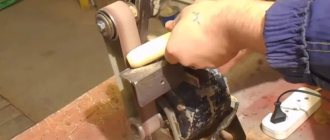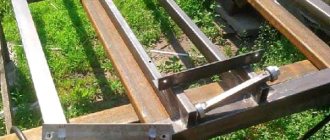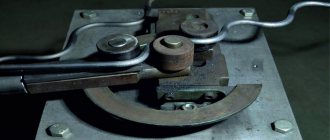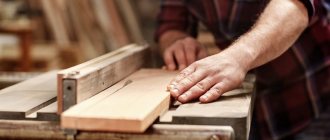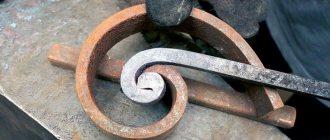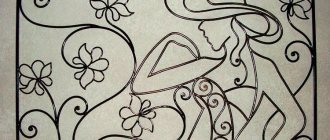Forged metal products add color to any interior and look very aesthetically pleasing. But not every home or dacha owner wants to have the standard solutions that the market offers. In addition, forged decorative elements are very expensive.
Homemade device for cold forging
Hot forging requires serious skills, equipment and work space. The ideal solution for realizing your design fantasies are cold forging devices. Not everyone can afford to buy such machines, but making the device yourself is not so difficult.
Types of machines
Basically, all devices that are intended for the manufacture of metal parts using cold forging are characterized by a manual drive. Few of them operate on the electric drive principle, although such a structure can be built with each of the devices. The only question regarding the drive is its feasibility, because the cost of the energy resource that powers the unit and the complexity of the installation process of the mechanism may not be justified if they are correlated with the amount of work performed and its regularity.
The table shows all the devices that operate using a manual drive and are related to the cold forging process.
| Device | Short description |
| Twister | With the help of such a device, the metal is twisted, spirals and curls with a narrow core are formed. |
| Torsion bar machines | With the help of such a machine, screw-type rods are twisted, and it is also possible to produce large spirals and filaments (baskets, lanterns and bulbs). |
| Inertial stamping machines | They are intended for making connecting parts with decorative components, making patterned tips and various small patterns and reliefs. |
| Bending machines | There are several types of such machines: push, broach and combined types. The first variety is needed in order to obtain wavy bends or to bend a rod in a zigzag manner. The extended variety is in demand when it is necessary to make a ring, curl or spiral with a wide core. Using the combined variety, you can build any of the listed elements. |
Help: very often in some sources you can find the name of machines designed for torsion as well as for machines that do winding - twisters. However, this is not entirely true; machines that twist metal are torsion bar machines.
Video on how to make a cold forging machine with your own hands.
Which machine is most needed?
Do-it-yourself cold forging machine: which one is the most necessary and which one to start with?
There is no clear answer to this question; you must decide for yourself. To make a smart decision, let’s go through the main types of machines to have an idea of their functionality and, most importantly, DIY manufacturing methods. You should remember what materials you will have to work with during the cold forging process: these are metal rods or rods with a diameter of no more than 14 mm, squares and strips with a thickness of approximately 3 to 6 mm with a width of no more than 25 mm.
A complete gentleman's set of machines in the workshop for full-fledged work will look like this:
- twister with snails for obtaining spirals of various radii;
- bender for bending arcs and parts at different angles;
- wave for curved parts and processing of metal pipes;
- globe for obtaining large arcs from profiles;
- flashlight for bending parts;
- volumetric
You don't have to have it all at once. It’s quite possible to start work if you have two machines from the first two points - a twister and a bender. Forging with your own hands has a great advantage: you can choose what to do and where to start. Let's start the review with the most popular machine - the twister or the famous snail.
Differences of cold forging
There is such a thing as “stamping”, which is sometimes confused with the cold type of forging. Cold forging itself has 2 principles according to which this process can occur. The table shows the differences between the processes.
| Process | Description |
| Stamping | The stamping process can be described as the extrusion of certain shapes using a punch that operates at a high level of pressure. An example of the stamping process is an aluminum can. Heating of the metal is not used in this case. The ability to apply such technology at home is hardly possible, since it is impossible to create the necessary conditions for this. |
| Cold forging type (riveting) | This type of cold forging, in essence, is cold hardening, namely, a certain number of blows of very high force are carried out in the process, which allows the structure of the metal to change and become the required parameters in size and shape. This manipulation is carried out using a hammer, which you can also build with your own hands. |
| Cold forging type (bending) | Another type is bending. With this technology, the metal structure remains the same without changing its characteristics. This type of forging can be used at home; all you need to do is create a cold forging machine with your own hands. |
Cold forging, which is carried out on the principle of bending, is quite simple to do, especially if you have special stationary equipment that significantly facilitates the process. The advantage of this variety is that you can assemble almost any cold forging machine with your own hands without much expense.
Video review of a manual machine for forging metal
Maybe you need a punch? Main concepts
You've probably already noticed that on our website we love to point out anything that's wrong. Now, too, we will not change ourselves: the concept of “cold forging” in its usual meaning is fundamentally incorrect, read carefully, we will explain.
First, what is forging: it is the processing of metals heated to forging temperature, that is, to the temperature when the metal becomes soft and can be deformed. Blacksmithing is all about forging - with a hammer, an anvil, a forge and mighty bearded blacksmiths wearing leather aprons.
Blacksmithing products are an exclusive and expensive business. And, in general, it is already exotic, if we exclude stamping, which is done automatically and in huge volumes.
Stamping is the extrusion or deformation of metal using a stamping press with a special matrix - a nozzle at the end. This is what it is - a punch that is made from the highest strength steel. Stamping can be hot, with heating of metals to forging temperature, and cold, without any heating. You don’t have to look far for an example of cold stamping - these are all metal drink cans.
Types of forging machines.
We are finally approaching working with metals in a cold way - without heating. Question: is it possible to deform metal without heating? Answer: yes, you can. The only way is mechanical. It is called a not very serious word - riveting or cold hardening. To do this, you will have to hit the metal with a hammer until you are stupefied until its structure begins to change significantly.
This process is precisely cold forging - mechanical deformation of metal blanks using mechanical blows with a hammer. If you decide to take up peening forging, then we say hello to your family and neighbors in advance - they will face serious challenges.
But seriously, there are fans of cold forging using the riveting method, we wish them success and move on to pseudo-cold forging, as they used to call it.
Mechanical deformation of metals using various machines without heating is more correctly called metal bending, because in this method of metal processing, craftsmen bend metal rods. They don't do anything else - they just bend. Another question is how and where they bend, along what axis, but all these are artistic aspects of metal bending, which we will also dwell on, but later.
The most important thing is that in the future we will call this process cold forging - as it is done in all sources, so that there is no confusion. It’s just that now we understand the methods and understand what the essence of the so-called “cold forging” is.
By the way, do you need a punch? It's a beautiful word. You won't be involved in industrial stamping of metal blanks, will you? But artistic forging with your own hands is a very real possibility at home. There is even light stamping along with punches... Let's look into it further.
Construction of cold forging machines
Each device for cold forging has its own characteristics and parameters. In order to easily make a cold forging machine with your own hands, you need to understand what each of them is.
| Machine | Device | |
| Bending machines | The design of this device is such that by changing the rollers and wedges, the size of the waves and bends changes. They can bend rods up to 16 mm. The only caveat of this device is that it cannot be made independently, because it requires processing and turning many parts of the exact size. The cost of such a device is low. | |
| Twister | The unit works by equipping it with a special template, onto which the piece of metal being processed is pressed. The pressure must be very high, so those who work on the twister must have sufficient strength to do this. In addition, the safety of the template itself is ensured by the presence of a persistent horn (end). As for the middle horn, which is otherwise called the encircling horn, it should be made in such a way that it can change its position and be fixed in it. The efficiency of work depends on this, especially for those who are starting the process for the first time. | |
| Base with spacers | This unit will allow you to make patterns of absolutely any variation. The design itself is very simple and consists of a plate made of durable and reliable material into which spacers are screwed at a certain distance. For such purposes, you can use bolts with sizes from m8 to m24. The thickness of the metal depends only on the skill of the person working on the machine. Basically, this device is well suited for metal with a thickness of 6 mm. | |
| Snails Twister machine | With collar | This installation consists of a base plate on which a special coil is located. This coil is used as a template for the future product. The peculiarity of the machine is that the “snail” template is divided into several parts, which are secured to each other using special connecting elements, which allows the template to vary in shape during operation, which creates various kinds of waves and bends. There are also disadvantages to this design, since in order to make such a machine for cold forging with your own hands, you need to select a very durable material that will not bend over time. Also think over the connecting loops, which are quite vulnerable, given the amount of force with which the entire process of bending the metal occurs. |
| Lever type | In this type of snail machine, the template is attached very firmly to the base. Due to this fact, its productivity is lower, however, its reliability is greater. Using a special lever, the metal plate is pressed against the template; at the same time, the movable roller must be moved during the process. To make such a machine for cold forging with your own hands, you can use steel material, which is distinguished by its strength, and the roller can be made from a regular roller bearing. In general, the design is similar to a pipe bender. | |
| Torsion bar machine | Such a device will be good for screw twisting rods. Such a machine is made from a cylindrical metal base and two fastening and simultaneously twisting elements. It is advisable to equip such a structure with a special pair of paws that will not allow the metal being processed to bend in ways that are not necessary. The principle of operation of the machine is such that the rod is placed in the elements holding it, clamped at one end, and at the other end, using a rotating spindle, it is twisted to the desired size of the helical wave. | |
Read also: Do-it-yourself Koschey metal detector diagram
Types of equipment for manual cold forging of metal
To process metal products and create forged elements, special forging equipment is required. Enterprises produce a variety of mechanisms that facilitate human labor, speed up production and allow achieving high quality finished items. There are various machines for hand cold forging on sale. Before you learn how to make a homemade machine, you need to familiarize yourself with the mechanisms for arranging a blacksmith's workshop.
Snail machine
It is considered a universal device, which is intended for the manufacture of spiral-shaped products. Experienced blacksmiths claim that this is one of the simplest devices. The snail with a collar is made from a cast base on which a movable twisted conductor is fixed. Using the gate, the blacksmith begins to move the mechanism, and the workpiece is twisted in a spiral. Both cold and heated metal profiles and rods can be used as consumable raw materials.
Torsion bar machine
This device allows you to twist several steel rods into one common piece. The design consists of a cylindrical base on which two twisting elements are fixed. The twisting parts are also clamps in which the workpieces are secured. Additionally, an electric motor can be installed that twists the rods to the required twist shape.
Gnitik machine
This is a classic manual cold forging machine. With its help, blacksmiths make any angle on workpieces. The design of the bend is a bending die with an eccentric drive. Additionally, they come with a template with metal rollers that are fixed on the frame. Various parts can be installed on the flex to expand its functionality.
Gnutik machine (Photo: Instagram / stanmann_ru)
Press machine
Many people who have worked in car repair shops or locksmith shops are familiar with presses. This cold forging mechanism can be assembled by hand. The machine consists of a cast frame and a piston mounted above it. An electric motor or gas drives a piston, which moves towards the working surface. The press is used to “bend” certain workpieces to certain angles.
Wave machine
With this device, blacksmiths create repeating twisted patterns (swirls with a small core). The design consists of two cast disks. They are secured to a metal base with bolts. In an improved version of the wave, it is possible to adjust the distance between the cast discs.
Equipping a torsion bar cold forging machine with an electric drive
In order to increase not only the efficiency of work on a cold forging unit, twisting rods into a helical wave, but also to increase the speed, as well as ensure stability and not be subject to overfatigue, you can install an electric type drive.
Working by hand, it is quite difficult to make all the decorative elements made of metal rods the same, since the uniformity of the rotational moment in such a situation will vary greatly. In order to avoid errors in the manufacture of products, you can use:
- axle shaft from the car, which is installed on the drive axle;
- you will also need a differential gear pair;
- For protection it is worth using a casing.
From the listed devices you can build an electric drive for a torsion bar machine. It is better for such an engine not to exceed power ratings of 900 rpm and 3 kW.
Building a curl for the machine with your own hands
Before you start creating a cold forging machine with your own hands, you need to be able to calculate the parameters of a template spiral, because there are practically no special programs for such purposes. Such a template should not only be technically competent, but also have an attractive appearance.
The calculations for this pattern are based on a logarithmic spiral. Some nuances during construction can be highlighted in the following list:
- the beginning of the construction is taken at point R0;
- the turning radius will be equal to a fixed angle;
- the length of such an angle must be multiplied by the divergence of the coil;
- the discrepancy in the standard version is generally taken to be 1.2;
- for simplicity of calculations, as well as maintaining accuracy, the bending angle is best taken at an angle of 45 degrees;
- if there is a need to build a template that will have a denser spiral, then the 8th part (s) of the unit distance from the spiral should be added to the radius;
- As for r0, it must be equal in cross-sectional size to the diameter size of the workpiece for the spiral.
Important: r0 can take any value, it all depends on what characteristics the metal is used for the workpiece, namely its density.
Taking into account all the nuances, you can start making a “snail” template; for this, it is best to be able to solve equations that have a cubic degree and higher. There is no exact formula for calculating such a device, but there is one that allows you to achieve the optimal result. The sequence when constructing a spiral template can be like this:
- the initial point r0 is determined first;
- the turns that the template will have are taken arbitrarily, their number can be any;
- using tabular data, you should calculate the diameter (b), while ensuring that it is smaller in width in the opening for the template;
- using the formula, the radius R is calculated;
- the last step is to transfer all the obtained points in accordance with the scale, after which you can proceed directly to construction. In the process, let’s adjust the radius R in the final version using a similar formula.
Help: if it becomes necessary to calculate intermediate values, then this is done in accordance with the geometric proportion.
Hot Forging Equipment
If we compare the cold and hot forging methods, we can immediately say that the first method requires much more skill from the worker, the presence of some artistic skills and, of course, the ability to work with a set of necessary tools.
Hot Forging Equipment
Forging of the material occurs after it is preheated in a forge furnace. It's called a forge. The forge is equipped with equipment for forced air supply. Heating is carried out to a given temperature and then transferred to the anvil. This is a metal plate on which impact processing of a heated workpiece is carried out. It is performed using hammers and sledgehammers of different weights. One worker, with a light hammer, strikes the desired place, and the second, armed with a heavy hammer or sledgehammer, strikes a strong blow to the designated place. After the workpiece has cooled, it is again loaded into the oven for heating. All movements of the part during its processing are performed using pliers with long handles.
Hand hot forging
In addition to the above-mentioned basic tools, during hot forging, many special tools are used that allow cutting hot metal and forming complex surfaces during hot forging of metal.
Forge
To heat the workpieces, furnaces are used, which are called forges. Its design includes several components. In particular:
- barrel made of fire-resistant material;
- hearth, with built-in grate;
- air supply and exhaust systems;
- working window through which long workpieces are fed;
- a chimney through which combustion products are removed.
Gas forge forge
In addition, the forge also includes a quenching bath. The operation of a classic forge is based on the unique reducing ability of carbon. It is this ability that successfully resists the oxidation of the workpiece, that is, its combustion. The calorific value of carbon is also important here. The fact is that when supplying air, it is necessary to regulate its quantity. There should be enough of it to burn the carbon, and the heat generated will raise the temperature in the furnace even higher.
In addition, the air supply to the forge must be adjusted so that the supplied oxygen is not enough to oxidize the metal. But if the heated workpiece is kept in this state for more than the required time, then it will become oversaturated with carbon. There is such a term - overdrying, that is, the metal becomes very fragile. By the way, cast iron can be used as an overdried metal.
Muffle furnace
Equipment that is used to heat parts made of different materials to a given temperature is called a muffle furnace.
Muffle furnace
A distinctive feature of this equipment is the presence of a muffle. So, they call a part that protects the part from contact with fuel and combustion products and at the same time serves as a chamber in which the part is heated. In practice, two types of such furnaces are used, with a permanent and replaceable muffle. In the first furnace, the loaded parts undergo all operations - from heating to readiness, in the second, only until cooling. That is, as the required temperature and a certain holding time of the workpiece are reached, one muffle is removed and another is installed in its place.
It should be noted that both the forge and muffle furnaces can use different types of fuel - gas, coal, firewood, light and dark oil products, etc.
Anvil
One of the key tools used for both cold and hot forging of metals is the anvil. It is on its surface that blacksmiths deform the workpiece and bring it to a finished form. The anvil is heavy and therefore it is rigidly fixed to a wooden block.
Anvil - Key Tools
The structural anvil consists of:
- horns;
- platband with holes;
- bases with paws for installing an anvil.
For the manufacture of this tool, 45L steel is used. It should be noted that anvils are products manufactured in accordance with a number of GOSTs. For example, GOST 11396-75 normalizes hornless products weighing from 92 to 200 kg, and GOST 11398-75 defines the requirements for products with two horns and weighing from 100 to 270 kg.
The hardness of the material from which anvils are made is 340 - 477 HB.
Construction of a cold forging machine
When drawing up a drawing to further create a template for the machine, it is best to make sure that it has the maximum number of different variations regarding bends and waves. Having such blanks, you can create a cold forging machine with many interchangeable attachments, which will make it possible to produce various patterns and monograms.
Sequence of actions when creating a device:
- Initially, you will need a metal sheet, the size of which will depend on the number of patterns placed on it. The templates themselves should be placed in such a way that there is room for the manufacture of products, because during the process the material from the nozzles may shift due to lack of space. Also, if the templates are not sufficiently spaced from each other, complications may arise in the work.
- As for the variations of the templates themselves, they can be either simple or contain more than one turn of the monogram. You can make a similar ploughshare-type snail and think through the design of the bends in the disassembled and assembled state. At the same time, you should be careful when selecting the material for fixing the sliding parts - it should be as durable as possible.
- The change of nozzles can be ensured by making a rectangular slot; replaceable templates for forging can be inserted into it. They should all be attached to metal plates shaped like a rectangle. Fastening of such nozzles will be ensured using bolts.
Video instruction
Assembling the device
This version of the machine is used as an example because of its simplicity. Knowing the basic principles and sequence of equipment design, you can upgrade it at will. To assemble all parts of the equipment into a single whole, you will need to use:
- drill with carbide type drills;
- welding machine;
- a saw cutting metal or a hacksaw;
- metal sheet of the selected size;
- round metal pipe;
- metal rod;
- bearings of different sizes;
- bolts size M8.
To assemble a cold forging machine with your own hands, you need to use a proven sequence of actions:
- Initially, you need to assemble a stand that will serve as a support. To do this, all its components (pipe sections of the same size and the joints between them at the top and bottom edges) must be connected into a single whole. The design may resemble a stool in appearance. The connection is made using a welding machine, and the sections are cut with a saw.
- The next step is cutting the metal sheets. You should get circles of equal diameters and four triangles with equal sides. Triangular-shaped elements must be welded to the bottom of the connected pipe structure in such a way that something similar to a pyramid is formed. The base, which has a wider area, must be welded at the central point of the cut circle.
- Four strips that are located horizontally must be attached to a circle with an already welded element. This should be done using bolts; for this you will need a drill to make the holes.
- The next step is the construction of the handle. To do this you need to use two rods of different lengths. Their sizes can be determined by correlating them with the diameter of the circle. One rod should be commensurate with the diameter, the other should slightly exceed its size. When bending the first rod, you should maintain an angle of 30 degrees. Then weld both rods to each other, and then weld another rod into the lower part. There should also be a jumper between the first two sections, to which a lever is attached by welding, which should maintain the direction towards the structure made of rods.
A bearing for future directional variability in the device must be attached to the end of the attached lever, as well as to the segment located at the bottom of the structure. The upper section serves as a mount for a metal coil, which must be installed horizontally - it makes it possible to bend the metal. On the lower side of the segment, where there is a free end, a hole should be made equal in diameter to the size of the pipe section.
Read also: Copper bracelets: benefits and harms reviews
- The last step in the algorithm of actions when constructing a machine for cold forging with your own hands will be the connection of the designed handle with a part of the device similar to a “pyramid”. These elements are fixed after putting on the handle with a wide-diameter nut, to which it is first necessary to weld a metal circle, which will allow the template itself to be attached to the machine. Next, the “snail” template is attached by welding.
Anyone who decides to take up forging seriously and make a cold forging machine with their own hands should be very scrupulous at the stage of creating drawings and calculations. Otherwise, the creation process is quite simple, and once you understand the principle of equipment design, you can come up with various variations of it that will help improve the product.
One way to decorate areas is to use forged items. Fences, benches, gazebos, stair railings and other similar structures look very decorative. Moreover, in most cases, these products are not forging in its traditional sense. Most often, this is done not in a forge or with a hammer and anvil, but with the help of some devices that allow you to create a wide variety of patterns and products from metal strips and square rods. To make such products you will need cold forging machines. Some of them you can make with your own hands, others are easier to buy.
Types and purpose of forging machines
*
The mechanism will make it easier to work manually and create unique products. For cold forging, craftsmen use various equipment that minimizes physical stress. human effort and allows for the following basic actions:
- bend the profile at the required angle;
- make spirals or curls;
- twist the parts lengthwise.
Various mechanisms help create unique designs, artistic canvas for a gazebo, decor for a park bench, and other items for various purposes.
Types of devices
Decorating machines make it possible to create parts that are similar in shape and parameters in a short time interval, helping to reduce their cost and production time.
Such machines are profiled (perform only one action) and universal. The following special machines are distinguished:
- gnutiki;
- snails;
- torsion bars;
- stamping.
Universal models consist of special equipment components in different combinations.
Machine "snail"
"Snail"
*
The algorithm for assembling a cold forging machine with your own hands will not cause any difficulties. During the creation of a cochlea, 3 types of construction are possible, and these are relative. Each specialist makes curls, spirals and bends of the product in his own way.
There are 3 types of mechanisms according to the type of execution:
- monolithic with a fixed bending pattern;
- with a removable bend, making it possible to make various curls;
- with collapsible curl components and a rotating tabletop to obtain complex bending profiles.
“Snail” design
Installation of the machine begins with the design of the main components of the device:
- Frame. The mechanism must be made of metal. Wood is completely unsuitable for assembling the device: prolonged and excessive loads destroy the wood after several uses. The main material used is a corner, thick-walled pipes or a channel.
- Tabletop. It is made from a metal plate, which is cut in the shape of a circle, 0.4 cm thick. A second tabletop is cut out of such a plate, which will repeat the shape of the first. The components are located on the latter and the workpieces are bent. During cold forging, the tabletop will take a large load, so there is no need to save money and create it from thin sheet iron.
- Main shaft and lever. The shaft is located in the middle, surrounded by table tops. Fixed to the frame with 4 triangles. The mechanism is made of a pipe with a thick wall of the required diameter. The lever is attached to the shaft by means of a ring and rotated around its axis. As an aid, a roller is installed on it to bend the rods.
Torsion bar machine
*
A number of users carry out ordinary twisting without using a machine. One end of the part is clamped in a vice, and the second is turned thanks to a standard collar. With this technique, the workpiece being processed is twisted, but sometimes it is stretched. To avoid this, a guide structure is constructed as a gutter. Should be considered:
- length of the groove - it cannot be longer than the part that is reduced during deformation;
- width of the groove - it is required that it be twice as wide as the product, since it will increase during deformation.
It is possible to achieve the expected results without equipment - such efforts will require effort and a lot of time. Those who prefer to assemble the necessary device must design such special equipment.
Torsion bar machine
Assembling such a machine yourself is possible in 2 variations: standard and universal. The first will be an improved way to work with a vice, and the second will provide a chance to create unique parts.
The main working force that is required to deform the material is taken by the support, therefore the base of the device being created must be highly durable. For such purposes, an I-beam or 2 channels are used, which are welded to each other. Stability for the frame is added by the paws, which are welded to the device. Then it is possible to manufacture the remaining elements - the tailstock and the spindle.
The components of the mechanism made from a profile pipe with your own hands contain cartridges, the purpose of which is to place them inside the workpiece. They must have strong latches (for secure fastening). Due to the reduction in the length of the product used during twisting, the tailstock is made sliding. It is permissible to construct it from a vice, securing it to the base with bolts.
The movable element of the spindle is turned using a handle, which provides for the presence of several levers that have the required length to dampen the applied forces.
Important! It is possible to add rubber bushings to protect your hands from slipping.
Assembly of the torsion device
*
The main difference in the installation algorithm of a universal device will be the design of the moving element. It involves a screw feed when making lanterns and is fixed using standard twisting. Therefore, the active element is equipped with 2 spindles. This option requires a locking screw for the sliding headstock.
When you need to make a part that is twisted only on a specific fragment, limiters are added to the device. They are made according to the tailstock principle - there are special clamps and there is a sliding option.
Work in such a situation is extremely tedious; obtaining high-quality products is a labor-intensive process. Therefore, equipping the product with an electric drive will be the best solution.
Machine "gnitik"
The device is efficient, massive, and easy to install. But a significant disadvantage is that it is difficult to find and fit the parts. The purpose of the device will be to bend the part at different angles, therefore it will be necessary to exert significant effort on it, therefore, the installation requirements will become higher.
For the frame of the device, a thick steel frame is selected. Please note that the device is attached to the table. Basically, fastening is done using a bolted connection, for example, as in a vice. In the middle of the frame there is a guide that is flexible. It is activated using an eccentric mechanism fixed on the frame frame. As an aid, 3 stops are installed, which create an unusual “fork” - these are the working components of the device. Taking into account the bend profile, they change: round shafts - to make a wave, “hammer” - to form corners.
"Gnutik"
Working components are made only from special steel. They will be responsible for the strength of the entire structure. To process and customize products, you will need special skills and appropriate tools. Therefore, when there are difficulties in ordering, purchasing or manufacturing main components, it is recommended to purchase the device in a store. Its price is not too high, but it can additionally be used to bend pipes.
Wave machine
It is more logical to call the product in question a controlled wave. The device is equipped with 2 steel disks with a diameter of 14 cm. They are fixed with bolts to the tabletop. An axis is fixed to the main disk, which rotates the universal knob.
You need to control the device in question by changing the distance between the disks. As the collar rolls around the rod, a pattern is formed. When the rod is removed from the jig, a pattern is formed on the second side.
"Wave"
Machine - press
*
To form the tips of the rods, you will need to use a press. The device in question functions similarly to a flywheel: initially the rod with weights rotates, and the screw striker is retracted all the way back. Then another stamp is inserted inside the socket and the workpiece is placed. Afterwards, the bar will quickly spin to the opposite side. The striker will hit the tail part of the die, as a result of which the force necessary for stamping purposes is generated.
Parts made by cold forging are joined using 2 methods:
- Welding - products are welded, the scale is ground off with a grinder or other equipment.
- Clamps - this type of connection looks much brighter.
The blanks are painted using special enamels or acrylic paints.
Press
What kind of devices are used?
Cold forging is characterized by various curls, bends, twisted rods, etc. Almost every type is made on a separate device - a specific machine. They can be driven manually or electrically. For small volumes “for yourself”, manual cold forging machines are used. Although they are not particularly productive, they are much easier to manufacture. If it is necessary to put production on stream, similar devices are made, but with electric motors. In this case, there is almost no need to physically work, but the complexity of making the device increases significantly. In our material we will talk about manual machines for cold forging.
What devices are used:
Torsion bars. With their help, tetrahedral rods or strips of metal are twisted in the longitudinal direction. The result is twisted columns, which are also called torsion bars.
This is what a torsion bar and the machine of the same name look like
This is how they make a flashlight
Device for cold forging snail - for forming curls
For bending anywhere and at any angle - bending machines (bending machines)
Machine "Volna" - for the formation of the appropriate relief
Machines for shaping the ends of rods. In this case - crow's foot
For a beginning craftsman, the most relevant machine for cold forging is a snail. Only with its help you can make many interesting things - from a fence and gate to a bench and other similar products. In second place in terms of necessity is a torsion bar machine. It adds variety to the details. All the rest can be purchased or made as you improve and gain skill.
Homemade “Snails”
In essence, this is a modernized bending machine (pipe bender), but these improvements make it possible to easily make curls from fairly thick rods (up to 10-12 mm cross-section) and repeat them with a high degree of accuracy.
One of the homemade cold forging machines
These cold forging machines have several designs, but the easiest to implement is the one with a round table with a central leg. A lever with rollers on bearings at the end is movably attached to the leg. They make the bending process easier.
The table surface can be made of steel sheet with a thickness of 10 mm or more. For the leg, you can use any thick-walled round pipe. It is important to make the structure stable, since lateral forces will be applied, so side posts, spacers, and a stable base are needed.
Drawing of a cold forging machine “Snail”
It is easier to make a lever from a square pipe with a thick wall - at least 2-3 mm. The cross-section of the pipe is 25*40 mm or so. Attaching the lever to the leg can be done on a bearing, or you can simply take a small piece of thick-walled pipe of a larger diameter, put it on the leg, and weld a stop strip on the bottom so that the lever does not fall down. The option with a bearing gives easier movement, but if there is lubrication, the second option also works.
Lever mounting option
The shape of the lever is also important. The lever is double, the upper part is working, the lower part is supporting. Wherever there are connections, it is advisable to add reinforcement, since the efforts are significant.
The lever must be reliable, with reinforcement
A mandrel or jig is fixed on the table - the shape along which the curls are bent. They are made in different diameters so that you can make curls of different diameters. Such mandrels can be prefabricated to form a larger number of bends. Each such sample must have rods that are installed in holes in the table. This is how this template is fixed. Also, its shape must be designed in such a way that the end of the rod is well fixed in it.
Variant of conductors for the snail
Often, mandrels are machined from a metal circle of a suitable diameter using a grinder, but there are options made of metal with steel plates welded onto it, curved accordingly.
How to make a similar machine for cold forging is in the next video. There is also a good description of how to bring the ends of the workpiece to a decent state - ordinary raw edges look very rough. There is special equipment for processing them, but, as it turns out, you can do it without it.
Making a snail with a lever
Drawing of a forging machine.
Before you begin the practical part of the work, you need to prepare theoretically. We are talking about calculations and drawings of the machine and its parts. Nobody will give you the exact dimensions, because this is an independent design.
Much will depend on the availability of similar materials, the scale of future cold forging work, the dimensions of the room where you are going to work and many other factors. The main thing is the principles that you need to understand in order to make a homemade cold forging machine with your own hands - the most convenient option for you and only you.
Here's what you need to gather before you begin assembly:
- metal plates or tabletop cloth with a thickness of at least 4 mm;
- metal round pipe for a rack or frame;
- metal rod;
- bearings of different calibers;
- drill;
- welding machine;
- hacksaw for metal;
- M8 bolts.
Basic parts
The twister has only four basic parts. Pay special attention to their preparation and, most importantly, installation:
- frame or stand;
- table top;
- main shaft;
- lever arm.
Rack
Only made of metal, no wooden beams. We place it in a thoughtful place so that you have access to the machine from any side. The machine will be subject to heavy loads, so the best option may be a thick-walled pipe or a metal corner.
It is best to concrete the stand directly into the floor, it will be reliable. Externally, this design may resemble a stool. As strong as possible - this is the main principle of producing a countertop stand. Therefore, it is better to connect metal parts by welding.
Tabletop
Homemade forging machine.
The most important part of the machine, which is best made from a metal plate with a decent thickness, preferably at least 5 mm. In the production of forging machines with your own hands, you cannot save on the thickness of the metal, because the table top and other basic elements will take on a huge load.
The preferred shape is a circle. You need to make two of these tabletops: the second is needed for bending the rods and placing the snails.
Main shaft
From the same metal plate, cut four right triangles with equal sides. Weld the triangles to the bottom of the structure, and their base is in the center of the circle. Another shaft option is not made from triangles, but from a pipe with thick walls of a suitable diameter. Fasten either with bolts or welding.
Lever or handle
And again “as tightly as possible”: attach the lever to the shaft with a ring so that it rotates around it. Attach the bending roller to the top tabletop. It is very important to correctly calculate the length of the lever, which depends on the diameter of the tabletop circle. One rod should be approximately equal to this diameter, the second rod should be longer.
Bearings are attached to the lever at its end, this is done to provide greater freedom in the directions of movement of the lever. The lever elements and fixed triangles are secured with a special round nut with a large diameter.
Attachment parts
Be careful here, you need to choose the degree of complexity or, so to speak, “artistry.” We have three options for you.
- Simple static snail
The simplest and therefore most primitive option from an artistic point of view. You apply a drawing of a snail, that is, a spiral, directly onto the tabletop.
In no case do we ignore the requirement in the drawings - cold forging loves precision and thoughtfulness in everything.
Then cut out segments from thick metal strips repeating the snail pattern and weld them as firmly as possible perpendicular to the tabletop. Simple, but not at all ingenious: on this tightly welded snail you can only make the same simple bends without any flight of creative thought.
Metal bending machine.
However, it all depends on what you are going to forge. If, for example, you have plans for a long wrought-iron fence with a simple design, then a simple static snail will be the best option.
- Collapsible snail made of removable parts
Let’s say right away that this is the most popular option among amateur craftsmen. The contours of snails are also applied to the tabletop. Threaded holes are drilled along this contour. Snail segments from metal strips are prepared using cardboard templates, and exactly the same matching holes are drilled into them as on the tabletop.
The segments are not welded, but are secured with bolts or cylindrical stops. The main advantage is the ability to bend spiral parts with different radii and different numbers of revolutions.
- Modular system with different snails
An option with the greatest artistic freedom for forging with your own hands: instead of segments with stops, removable modules with different snails are used here - both in shape and size. The modules are prepared on separate metal platforms on which the segments are welded.
Of course, you need to tinker a lot with such a machine, but this game is worth the effort: you can forge real metal lace. It all depends on your plans: a simple fence or a lacy gazebo in the garden?
Torsion bar machine
As already mentioned, these cold forging machines allow you to make longitudinal bends on the rod. This is a relatively simple design. The main task is to fix one end of the rod motionless, attach a lever to the second, with which you can twist the workpiece.
A piece of profiled pipe with a thick wall (at least 3 mm) is suitable as a base. The retainer can be welded from the same rods, leaving a square gap of the required diameter. You can use a properly sized cable clamp (available at a rigging store). Any of these stops is welded to the base.
Cable holder - great for holding rods
Next, you need to somehow ensure grip and torsion of the second part of the workpiece. This can be done using two bearing units. A pipe of a suitable diameter is inserted inside, and a handle is welded to it on one side - the design resembles the letter “T”. On the other hand, a clamp is made in the pipe: four holes are drilled, nuts for 12 or 14 bolts are welded into them. The result is a good clamp - the bolts are tightened after the rod has been inserted.
Next - a matter of technique - use a lever to screw in the required number of turns. This is not to say that this work is for weaklings, but with a lot of leverage, everything is not so difficult.
An even simpler machine for making torsion bars using cold forging is in the next video.
Machine design.
To create any machine, you can use several options to choose from - collapsible, monolithic or solid. It is recommended to weld small rods along the entire length of the machine. For this purpose, it is worth drilling special holes at the work site. It is necessary to securely secure the ends of the parts that will bend. This forging method is very popular among blacksmith beginners.
Using a machine for cold forging of metal made by hand, an inexperienced craftsman will be able to make forged balcony canopies, handrails for stairs, various window grilles, fences, numerous home furniture, fences, various forged accessories and decorative items that complement the interior of the premises, on similar to grates for fireplaces. This is a good option for beginners.
